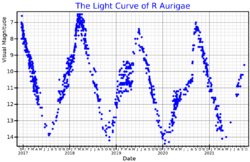Astronomy:R Aurigae
| Observation data Equinox J2000.0]] (ICRS) | |
|---|---|
| Constellation | Auriga |
| Right ascension | 05h 17m 17.6916s[2] |
| Declination | +53° 35′ 10.032″[2] |
| Apparent magnitude (V) | 6.7 to 13.9[3] |
| Characteristics | |
| Spectral type | M7IIIe[4] (M6e - M9e)[3] |
| U−B color index | +0.27[5] |
| B−V color index | +1.66[5] |
| Variable type | Mira[3] |
| Astrometry | |
| Radial velocity (Rv) | 7.8 ± 2[6] km/s |
| Proper motion (μ) | RA: 14.708[2] mas/yr Dec.: −14.685[2] mas/yr |
| Parallax (π) | 3.4958 ± 0.1327[2] mas |
| Distance | 930 ± 40 ly (290 ± 10 pc) |
| Details | |
| Radius | 300[7] R☉ |
| Luminosity | 11,530[8] L☉ |
| Temperature | 2,385[8] K |
| Other designations | |
| Database references | |
| SIMBAD | data |
R Aurigae (R Aur) is a Mira variable, a pulsating red giant star in the constellation of Auriga, at a distance of 930 light years.
R Aurigae has an apparent visual magnitude which varies between 6.7 and 13.9 with a period of 450 days.[3] The light curve varies strongly from cycle to cycle, sometimes having a pronounced hump on the ascending branch and usually having rise and fall times approximately equal. The cycle period has oscillated slowly between about 450 and 465 days. The discoverer of R Aurigae's variability is not known, but it was widely observed in the late 19th century and its spectrum was described in 1890.[9]
R Aurigae is catalogued as a component of a double star, with the 10th magnitude HD 233095, although the two stars are unrelated.[10]
References
- ↑ "Download Data". AAVSO. https://www.aavso.org/data-download.
- ↑ 2.0 2.1 2.2 2.3 2.4 Brown, A. G. A. (2021). "Gaia Early Data Release 3: Summary of the contents and survey properties". Astronomy & Astrophysics 649: A1. doi:10.1051/0004-6361/202039657. Bibcode: 2021A&A...649A...1G. Gaia EDR3 record for this source at VizieR.
- ↑ 3.0 3.1 3.2 3.3 R Aur, database entry, The combined table of GCVS Vols I-III and NL 67-78 with improved coordinates, General Catalogue of Variable Stars , Sternberg Astronomical Institute, Moscow, Russia. Accessed on line November 10, 2009.
- ↑ Skiff, B. A. (1994). "Photometry of Stars in the Field of R Aurigae". Information Bulletin on Variable Stars 4058: 1. Bibcode: 1994IBVS.4058....1S.
- ↑ 5.0 5.1 HR 1707, database entry, The Bright Star Catalogue, 5th Revised Ed. (Preliminary Version), D. Hoffleit and W. H. Warren, Jr., CDS ID V/50. Accessed on line November 10, 2009.
- ↑ 6.0 6.1 "V* R Aur". SIMBAD. Centre de données astronomiques de Strasbourg. http://simbad.u-strasbg.fr/simbad/sim-basic?Ident=V%2A+R+Aur.
- ↑ HD 34019, database entry, Catalog of Apparent Diameters and Absolute Radii of Stars (CADARS), 3rd edition, L. E. Pasinetti-Fracassini, L. Pastori, S. Covino, and A. Pozzi, CDS ID II/224. Accessed on line November 10, 2009.
- ↑ 8.0 8.1 McDonald, I. et al. (2012). "Fundamental Parameters and Infrared Excesses of Hipparcos Stars". Monthly Notices of the Royal Astronomical Society 427 (1): 343–57. doi:10.1111/j.1365-2966.2012.21873.x. Bibcode: 2012MNRAS.427..343M.
- ↑ "LPV of the Month December, 2016". https://www.aavso.org/lpv-month-december-2016.
- ↑ Mason, Brian D.; Wycoff, Gary L.; Hartkopf, William I.; Douglass, Geoffrey G.; Worley, Charles E. (2001). "The 2001 US Naval Observatory Double Star CD-ROM. I. The Washington Double Star Catalog". The Astronomical Journal 122 (6): 3466. doi:10.1086/323920. Bibcode: 2001AJ....122.3466M.
 |


